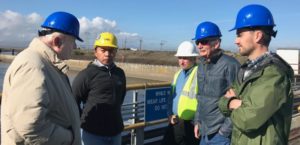The American Sportfishing Association’s (ASA) senior leaders met with several California members and partners in a three-day visit, hosted by the Golden Gate Salmon Association (GGSA), to learn about the challenges and opportunities facing the Chinook salmon fishery in California.

(L-R) Dick Pool, president, Pro-Troll, two representatives from the Bureau of Reclamation, Randy Repass, chairman, Golden Gate Salmon Association, and ASA Conservation Director Mike Leonard, discuss salmon recovery.
During their visit, dubbed “salmon camp” by Pro Troll President and GGSA/ASA member Dick Pool, ASA’s Vice President for Industry Relations, Glenn Hughes, Government Affairs Vice President Scott Gudes and Conservation Director, Mike Leonard, took part in a roundtable discussion with the GGSA, anglers, charter boat operators, river guides, commercial fishing representatives and environmental groups. Hughes will assume the role of ASA’s President on April 1.
Discussions focused on the importance of timely cold fresh water flows, habitat restoration and hatchery programs as they pertain to the fall run of Chinook which is the cornerstone of ocean and river fishing for salmon in California.
The ASA team was accompanied by Christy Plumer, Chief Conservation officer for the Theodore Roosevelt Conservation Partnership, and Soren Nelson, Pacific Southwest States coordinator for the Congressional Sportsmen’s Foundation.
Hughes noted, “Our Bay Area members went all out to provide us with an in-depth education on California salmon issues. Clearly, a healthy salmon fishery is essential to our industry and jobs.”
The team met with state and federal conservation and natural resource officials in Sacramento including the California Department of Fish and Wildlife, NOAA’s Central Valley Salmon office, and the U.S. Fish and Wildlife Service.
The team visited several facilities across the Central Valley including federal water pumping facilities, projects designed to reduce juvenile salmon losses as they journey down the Sacramento river to the Golden Gate and the Mokelumne River Hatchery which has been particularly innovative and effective at achieving results by increasing returns of Chinook Salmon and Steelhead.
Throughout the sessions, there were in depth discussions of new projects and procedures that could increase salmon stocks and harvest. ASA, GGSA, along with state and federal officials agreed to continue to work on these improvements.
Recent activity by Congress has created additional challenges for sustaining California salmon. In December 2016, Congress passed the Water Infrastructure Improvements for the Nation Act (WIIN), which included provisions to redirect water to agriculture and undercut environmental protection for salmon and other fisheries. ASA is closely watching bills that are currently being debated to extend these efforts and divert even more water for agriculture.
Gudes observed, “Over a century of diverting water and habitat destruction have pushed salmon runs to historic lows. The good news is that anglers, the commercial industry and many environmental groups have joined together to stand up for salmon. If California and the federal government could clean up Southern California’s air pollution in the past thirty years, clearly they have the ability to save and increase salmon runs in Northern California.”
Share This Article, Choose Your Platform:
Recent Posts


